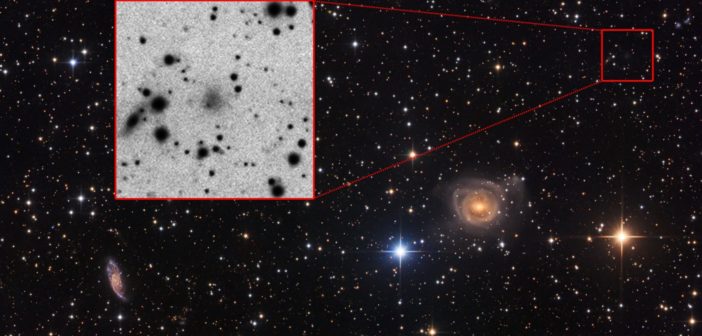Editor’s note: In these last two weeks of 2018, we’ll be looking at a few selections that we haven’t yet discussed on AAS Nova from among the most-downloaded papers published in AAS journals this year. The usual posting schedule will resume in January.
Discovery of a Low-Surface-Brightness Galaxy in the NGC 2655 Field
Published January 2018
Main takeaway:

In the field pictured in the top panel, NGC 2655 is the large galaxy that lies near the bottom left. The red crosshairs indicate the location of the new low-surface-brightness galaxy. Bottom panels show confirmation data and a FITS-cutout from the Pan-STARRS1 Surveys. [Adapted from Steiling and Crowson 2018]
Why it’s interesting:
The last few years has marked a boom in the discovery of extremely dim, faint, diffuse galaxies. By definition, these bodies are at least one magnitude lower in surface brightness than the ambient night sky; they have very few stars and are generally more than 95% non-baryonic dark matter by mass. This makes them excellent laboratories for exploring the properties of dark matter and dark-matter dominated galaxies.
What else we might learn:
Most low-surface-brightness galaxies are isolated, not lying near any other major galaxies. This has been used as an explanation for why they are so faint: without interactions with other galaxies to trigger star formation, they’ve stayed relatively dark. The newly discovered galaxy, on the other hand, does not appear to be isolated: it lies near the NGC 2655 group of galaxies, a group thought to have recently undergone interactions or mergers. If the low-surface-brightness galaxy is a part of the group (as opposed to appearing nearby by coincidence, which is also a possibility), this unusual association could teach us more about the behavior of diffuse galaxies.
Citation
Frederick Steiling and Dan Crowson 2018 Res. Notes AAS 2 11. doi:10.3847/2515-5172/aabf92

1 Comment
Pingback: Selections from 2018: A New Dim Galaxy Found – New